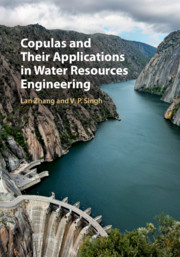Book contents
- Copulas and Their Applications in Water Resources Engineering
- Copulas and Their Applications in Water Resources Engineering
- Copyright page
- Dedication
- Contents
- Preface
- Acknowledgments
- Part One Theory
- Part Two Applications
- 10 Rainfall Frequency Analysis
- 11 Flood Frequency Analysis
- 12 Water Quality Analysis
- 13 Drought Analysis
- 14 Compound Extremes
- 15 Network Design
- 16 Suspended Sediment Yield Analysis
- 17 Interbasin Transfer
- Index
- References
15 - Network Design
from Part Two - Applications
Published online by Cambridge University Press: 03 January 2019
- Copulas and Their Applications in Water Resources Engineering
- Copulas and Their Applications in Water Resources Engineering
- Copyright page
- Dedication
- Contents
- Preface
- Acknowledgments
- Part One Theory
- Part Two Applications
- 10 Rainfall Frequency Analysis
- 11 Flood Frequency Analysis
- 12 Water Quality Analysis
- 13 Drought Analysis
- 14 Compound Extremes
- 15 Network Design
- 16 Suspended Sediment Yield Analysis
- 17 Interbasin Transfer
- Index
- References
Summary
In this chapter, we apply copulas to network evaluation and design. The network is considered to be comprised of rain gauges that are located in the southwest (seven gauges) and east central (three gauges) parts of Louisiana. To select proper rain gauges for network design, the kernel density is applied to model the marginal rainfall variables as that studied for rainfall analysis in Chapter 10. For the simplicity of illustrating the copula-based network design, meta-elliptical copulas (i.e., meta-Gaussian and meta-Student t) are applied to model the spatial dependence among rain gauges. The network design case study shows the appropriateness of the copula-based network design.
Information
- Type
- Chapter
- Information
- Copulas and their Applications in Water Resources Engineering , pp. 550 - 562Publisher: Cambridge University PressPrint publication year: 2019
